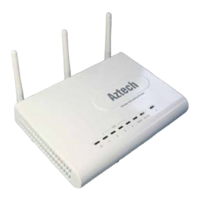
Do you have a question about the Aztech 4-Port Wireless N Router and is the answer not in the manual?
| Brand | Aztech |
|---|---|
| Model | 4-Port Wireless N Router |
| Category | Network Router |
| Language | English |
Router uses built-in firewall security to block service attacks and allows specific applications to pass through.
Settings can be done easily using a Web browser with a simplified user interface.
Details the layout and labels of the router's front panel components and indicators.
Details the rear panel ports (WAN, Ethernet) and controls (Reset).
Provides a flowchart outlining the steps for device installation and setup.
Guides users on creating a network diagram before setting up the router.
Advises on removing or disabling applications that may interfere with router installation.
Instructions on checking and setting default TCP/IP properties on a computer.
Steps to configure internet properties, specifically dial-up settings.
Provides instructions on deleting temporary internet files to clean the cache.
Illustrates and describes how to physically connect the modem, computer, and power adapter to the router.
Guides through accessing the Web Manager and using the Setup Wizard to connect to the internet.
Step 1 of the wizard to set a new password for the Web Manager.
Step 2 of the wizard to configure time zone and NTP server settings.
Step 3 of the wizard to configure WAN access type for internet connection.
Step 4 of the wizard to configure wireless network name and basic parameters.
Step 5 of the wizard to configure wireless security settings.
Instructions on how to connect wireless devices to the router after setup.
Steps to access the router's Web Manager interface using a web browser.
Overview of the main menus available in the Web Manager interface.
Provides a summary of connection, router, local network, and wireless network information.
Accesses the wizard to configure the router for internet connection and settings.
Section for configuring internet connection parameters via different WAN types.
Configures internet connection using a static IP address provided by the ISP.
Configures internet connection for DSL using PPPOE protocol.
Configures internet connection using PPTP protocol.
Configures internet connection using L2TP protocol.
Manages IP and DHCP server settings for the local area network.
Displays IP, MAC address, and expiration time of DHCP leased clients.
Sets the network name (SSID) and broadcast status for wireless clients.
Configures the wireless mode and channel number for optimal performance.
Adjusts transmit signal strength and data transfer rates for the wireless network.
Configures wireless channel bandwidth mode and extension channel protection.
Allows setup of WEP encryption for wireless network security.
Configures wireless security using WPA-PSK or WPA2-PSK with a pre-shared key.
Configures wireless security using WPA/WPA2 with RADIUS server authentication.
Enables Wi-Fi multimedia support and enhances wireless performance.
Adjusts thresholds for RTS/CTS mechanism and packet fragmentation for efficiency.
Configures beacon interval and DTIM interval for network synchronization and broadcast messages.
Restricts or allows access to the wireless network based on MAC addresses.
Extends network range by linking Access Points using Wireless Distribution System.
Enables Wi-Fi Protected Setup for automatic wireless client connection.
Displays MAC address, IP address, and RSSI of active wireless clients.
Allows enabling NAT and displaying the router's routing table.
Automatically adjusts network routes using RIP protocol based on fewest hops.
Sets up pre-defined pathways for network information to reach specific hosts or networks.
Redirects common network services to a specific machine behind the NAT firewall.
Blocks access to specific IP addresses or data packets from the local network.
Excludes specific devices from accessing the router based on their MAC addresses.
Blocks access to unwanted web content by specifying URL addresses.
Blocks access to specific network ports.
Protects against explicit attempts by hackers to prevent legitimate users from accessing a service.
Provides a zone for public servers to be visible to the outside world without compromising the private network.
Allows saving current settings to a file or restoring from a saved configuration file.
Configures Dynamic DNS service to provide a consistent domain name for the IP address.
Resets the device to its original factory settings, clearing all modifications.
Guides on updating the router's firmware to the latest version.
Allows changing the password for accessing the router's Web Manager.
Shows sent and received packet counters for wireless, Ethernet LAN, and WAN.
Displays system logs and alert messages, with options to set a remote log server.
Synchronizes system log timestamp with an NTP server and configures time zone.
Provides instructions to restart or reboot the router device.
Allows the user to end their current session with the router's interface.
Lists essential safety precautions for handling and operating the equipment.